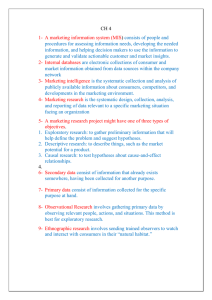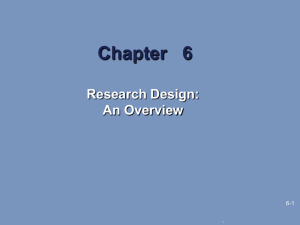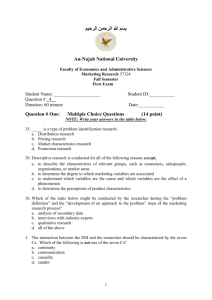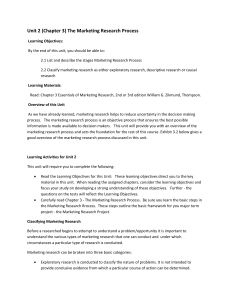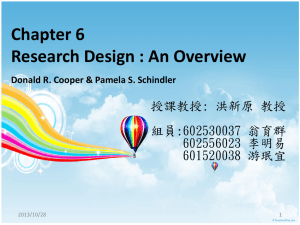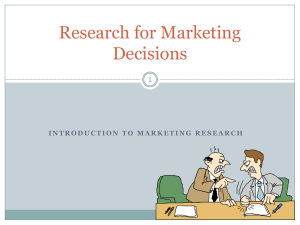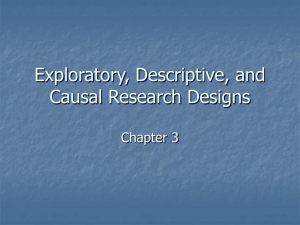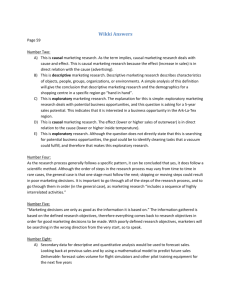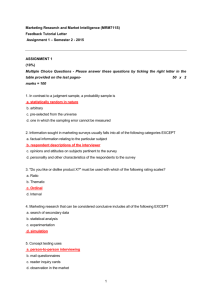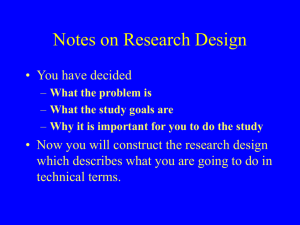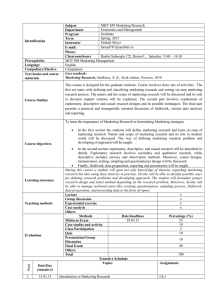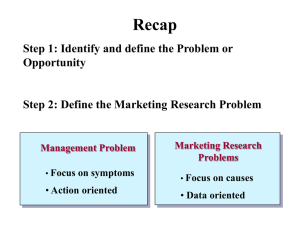The Research Design
advertisement
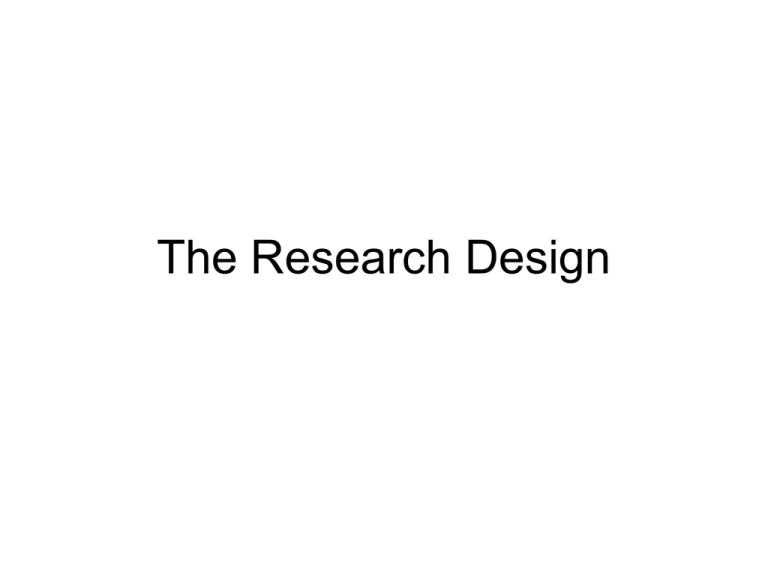
The Research Design What is Research Design? • A research design is the strategy for a study and the plan by which the strategy is to be carried out. It specifies the methods and procedures for the collection, measurement, and analysis of data. • It is a plan for selecting the sources and types of information used to answer research questions • It is a framework for specifying the relationships among the study variables • It is a blueprint that outlines each procedure from the hypothesis to the analysis Classifications of Designs • Unfortunately, there is no simple classification of research designs that covers the variation found in practice. Some major descriptions of designs are: – – – – – – – Exploratory versus formalized (descriptive & causal); Observation versus interrogation/communication; Experimental versus ex post facto; Cross-sectional versus longitudinal; Case study versus statistical study; Field versus laboratory versus simulation; and Participants perceive no deviations, some deviations, or researcher-induced deviations. • Exploratory study is usually to develop hypotheses or questions for further research • Formal study is to test the hypotheses or answer the research questions posed Power to Produce Effects • In an experiment, the researcher attempts to control and/or manipulate the variables in the study • In an ex post facto design, the researcher has no control over the variables; they can only report what has happened Purpose of the Study • Descriptive study tries to explain relationships among variables • Causal study is how one variable produces changes in another The Time Dimension • Cross-sectional studies are carried out once and represent a snapshot of one point in time • Longitudinal studies are repeated over an extended period The Topical Scope • Statistical studies attempt to capture a population’s characteristics by making inferences from a sample’s characteristics • Case studies place more emphasis on a full contextual analysis of fewer events or conditions and their interrelations A Participant’s Perceptions • Usefulness of a design may be reduced when people in the study perceive that research is being conducted • Participants’ perceptions influence the outcomes of the research Why do Exploratory Studies? • Exploration is particularly useful when researchers lack a clear idea of the problems they will face during the study. • Through exploration, researchers develop concepts more clearly, develop operational definitions, and improve the final research design. Data Collection Techniques • • • • Qualitative techniques Secondary data Focus groups Two-stage design Two-stage design • A useful way to design a research study is two-stage design. With this approach, exploration becomes a separate first stage with limited objectives: – Clearly defining the research question and – Developing the research design Descriptive Studies • In contrast to exploratory studies, more formalized (descriptive) studies are typically structured with clearly stated hypotheses or investigative questions. • Formal studies serve a variety of research objectives: Descriptive Studies: objectives • Description of phenomena or characteristics associated with a subject population (the who, what, when, where, and how of a topic). • Estimates of the proportions of a population that have these characteristics. • Discovery of associations among different variables. Causal Studies • The correlation between location and probability of account holding at BankChoice looks like strong evidence to many, but researcher with scientific training will argue that correlation is not causation. Who is right? • The essence of the disagreement seems to lie in the concept of cause. Causal Relationships • The causal relationships that occur between variables may be symmetrical, reciprocal, or asymmetrical. • Symmetrical Relationship: – Two variables fluctuate together but we observe the changes in neither are due to changes in the other, e.g., a correlation between low work attendance and active participation in a company’s camping club is the result of another factor, such as a life style preference. Reciprocal Relationship • This type of relationship exists when two variables mutually influence or reinforce each other; • For example, the reading of an advertisement leading to the use of a brand of product. – The usage, in turn, sensitizes the person to notice and read more of the advertising of the particular brand. Asymmetrical Relationship • Most research analysts look for Asymmetrical relationships. • With these we postulate/hypothesize that changes in independent variable (IV) are responsible for changes in dependent variable (DV). • The identification of the IV and DV is often obvious, but sometimes the choice is not clear. In the latter cases, the independence and dependence may be evaluated on the basis of: – The degree to which each variable may be altered. The relatively unalterable variable is the independent variable (IV) for instance, age, social status, present manufacturing technology etc. – The time order between the variables. The independent variable (IV) precedes the dependent variable (DV). Asymmetrical Relationships • Four types of asymmetrical relationships are: – – – – Stimulus-Response Property-Disposition Disposition-Behavior Property-Behavior • Experiments usually involve stimulus-response relationships. • Property-disposition relationships are often studied in business and social science research. • Much of ex facto research involves relationships between properties, dispositions, and behaviors. • See Exhibit 6.6
